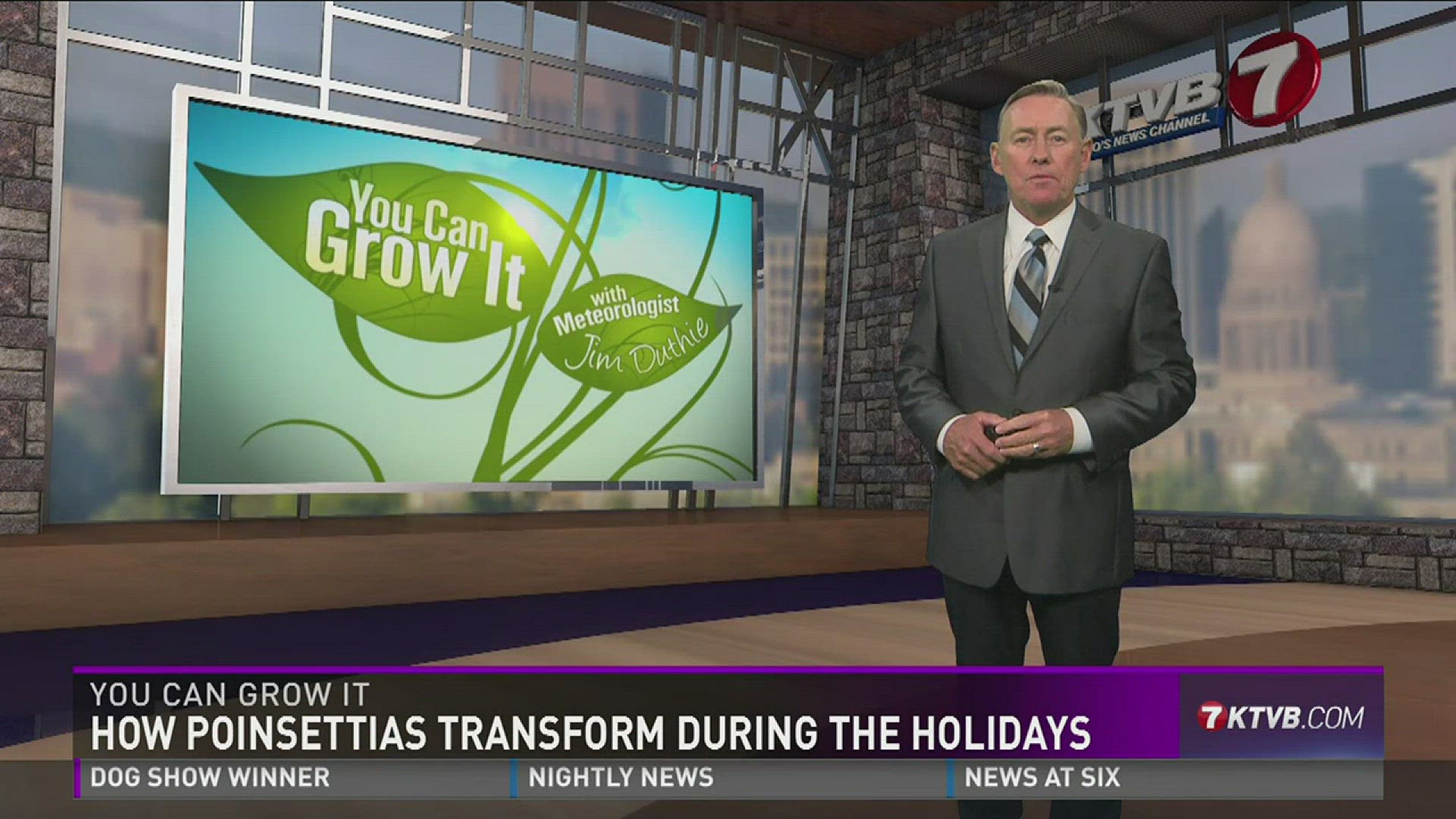Thanksgiving is here and Christmas is just around the corner. Holiday decorations are going up, and a favorite Christmas symbol is appearing in stores and displays around the area – those beautiful poinsettias.
Today on “You Can Grow It,” garden master Jim Duthie tells us all about these fascinating and beautiful plants, and shows us how they magically transform into all of their brilliant colors, just in time for the holidays.
They don’t grow wild around here, or even in landscaped yards and gardens. But one look at these bright red blooms, and you know it’s the holiday season.
Poinsettias are one of the enduring symbols of Christmas. But how do they get from a green plant to these colorful displays?
Poinsettias are native to Mexico, and were unknown in the U.S. until 1828, when an American named Joel Poinsett, who was serving as ambassador to Mexico, ran across them growing wild. There, they were known as the “flor de nochabuena”, or the Christmas Eve flower. Poinsett sent samples back to the U.S., where they soon became known as poinsettias in his honor.
Poinsettias thrive outdoors in warmer climates here in the U.S., like Hawaii, Florida, or parts of the Southwest, and often grow into large shrubs and trees up to 15 feet high.
But while Idaho is too cold for most of the year for poinsettias to grow outdoors, inside Edwards Greenhouses in Boise, conditions are ideal.
Garnette Edwards has run the business since 1986, taking over a family legacy that began in 1930 with her grandfather. From the beginning, the greenhouses have been heated almost exclusively by geothermal water, hot water from underground. In fact, Edwards is the longest-running geothermal greenhouse in the U.S.
“There’s so much research being done on varieties that need to be more cold growing tolerant, because of the price of heat,” said Edwards.
These plants have been growing since mid-June.
“We get them all by cuttings, and we get our cuttings pre-started, and we’ll get them through the summer ending about August 16th,” she said.
Right now there are about 9,000 poinsettia plants in the greenhouse.
“I think this year we probably have about between 32 and 35 different varieties.”
Including 10 to 15 different shades of red.
So what leads to poinsettias’ magical color transformation?
“It would be the shortening of the day.”
The color change is triggered by the length of daylight, just like the leaves on trees and shrubs growing outdoors. The plants need several hours of continuous darkness to initiate that color change.
“Fourteen hours is what they recommend.”
“What we do is, usually by September 1st, we have no artificial light on the greenhouse, in the greenhouse, from about September 1st until about the 30th of October.”
And as the days grow shorter, the colors become more pronounced.
What we think of as flowers, the part that changes color, are actually the leaves of the poinsettia, which are known as bracts.
“And those are actually transition leaves on the plant. And they are meant to draw, attract insects that will pollinate the flowers. The flower is actually the little center here, and that is called the cyathium.“
“So the red background and the bright yellow will bring insects from a long ways away to pollinate this.”
Think of it as the plant’s colorful make-up to attract bees and butterflies.
“Well, yeah, this is the lipstick and those are the lips.”
For weeks, the plants stay green. But then, around the third week of October, a subtle change begins, with a hint of red showing up in the leaves.
By mid-November, the full change is underway, as the poinsettias have magically transformed into a sea of vivid shades of red, yellow and white, with the colors growing more brilliant each day.
The classic red shades are by far the most common for holiday decorating, including the Capitol poinsettia tree, in the center of the Idaho State Capitol rotunda. This is the 35th year that Edwards’ poinsettias will make up that holiday tradition.
Poinsettias also come in many other colors, including pink, from this pale shade, to the vivid and eye-catching princettia variety.
And this striking pure white poinsettias, including this rose variety with its curled leaves.
Others come in shades of yellow, salmon and orange, as well as this beautiful golden poinsettia. There’s even one variety of light green called envy, as well as some known as novelties, with mottled, variegated and marbled leaves.
The colorful transformation of the poinsettias is truly magical, making it an iconic symbol of a magical time of year.
Here are a few simple tips to keep your poinsettias looking good right through the holidays. Put them in a somewhat cool location with bright, but indirect sunlight, away from heater vents and drafts. Keep the soil moist, watering every few days, but don’t overwater, making sure they have proper drainage.
And one more tip – if you buy your poinsettia from a store, make sure it is placed in a sack to protect it from the cold as you carry it to the car. Once spring arrives, and nighttime temperatures stay above 50 degrees, you can move your poinsettia outside for the summer.

